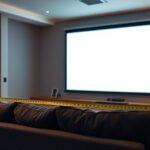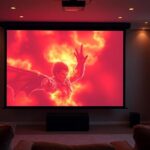Many believe ALR screens are always better for bright rooms, but white screens can work well with proper lighting control. It’s a mistake to think all ALR screens are the same, as material and design really matter. Price doesn’t always reflect quality, and high contrast content may struggle on white screens. Plus, ambient light rejection doesn’t mean you need total darkness. To understand the truth behind these myths, there’s more to discover below.
Key Takeaways
- Many assume ALR screens are only for bright rooms, but they also improve contrast in challenging lighting environments.
- Not all ALR screens are the same; material quality and design differences significantly affect performance.
- Higher price does not guarantee better quality; affordable screens can perform equally well with proper specifications.
- White screens excel in color accuracy and vibrancy, but struggle with glare and contrast in bright or challenging lighting.
- Ambient light rejection technology enhances viewing in daylight, but some misconceptions overlook the importance of proper placement and setup.
ALR Screens Are Always Better for Bright Rooms
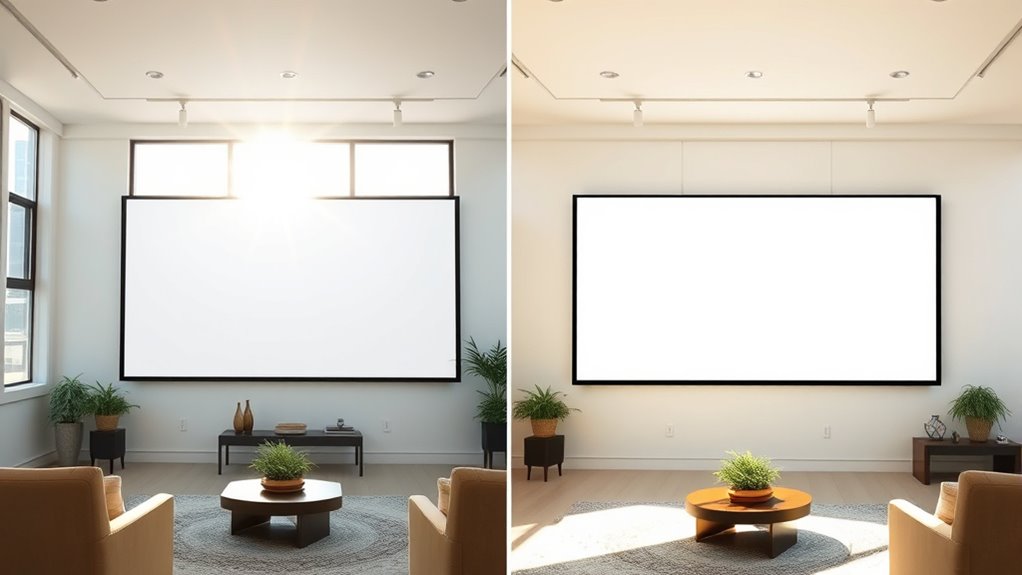
Are ALR screens truly the best choice for bright rooms? If you often watch in spaces with high ambient light, ALR screens can be a game-changer. They’re designed to reflect ambient light away from the viewer, maintaining image clarity even in well-lit environments. Unlike traditional white screens, ALR screens offer more screen flexibility; they’re engineered to handle varying lighting conditions without washing out the picture. This means you won’t need a dark room to enjoy vivid, high-contrast images. Their ability to reduce ambient light interference makes them ideal for bright settings. Additionally, contrast ratio plays a crucial role in how well a screen performs in such conditions, as higher contrast ratios help preserve image depth and detail despite external light sources. Understanding ambient light mitigation techniques used in ALR screens can help you determine their suitability for your specific needs. So, if your viewing space is bright and sunny, ALR screens might be your best bet for a clear, vibrant picture without dimming the lights.
White Screens Cannot Handle High-Contrast Content
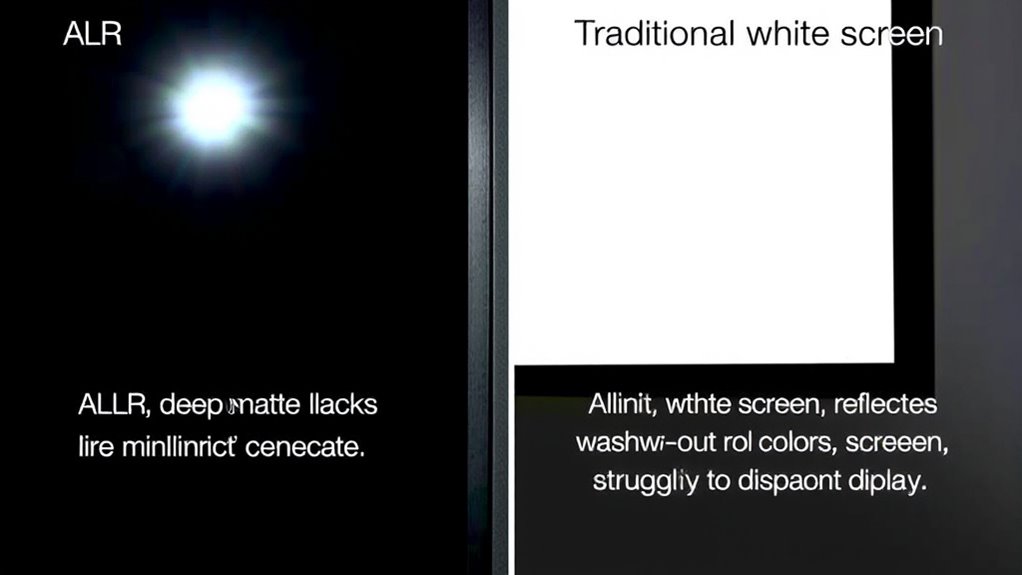
White screens often struggle with high-contrast content, making bright colors appear washed out or distorted. You might notice glare and reflection issues that hinder your viewing experience, especially in well-lit rooms. As a result, the contrast clarity diminishes, reducing the overall picture quality you get from your display. Additionally, data privacy concerns can limit the effectiveness of some display technologies that rely on data collection to optimize image quality. Furthermore, vibrational energy can influence how well a display performs, impacting color vibrancy and image sharpness in different lighting conditions.
Struggles With Bright Colors
Bright colors often pose a challenge for white screens because they struggle to display high-contrast content accurately. When you showcase vibrant hues, you might notice reduced color saturation, making images look dull or washed out. The brightness impact is significant; white screens can wash out bright colors, losing their vividness and depth. This happens because white screens rely heavily on ambient light reflection, which diminishes the intensity of bright colors and reduces overall contrast. As a result, you may find that your images lack the punch and clarity you expect, especially in well-lit environments. If you frequently display high-contrast, colorful content, a white screen might not deliver the lively, crisp visuals you desire, leading to a less engaging viewing experience.
Glare and Reflection Issues
High-contrast content can create significant glare and reflection issues on white screens, especially in well-lit environments. This makes glare mitigation essential, as bright reflections can wash out your image and cause eye strain. Reflection control becomes difficult on white screens because their surface reflects ambient light directly back to your eyes, reducing contrast and clarity. If glare isn’t managed properly, you’ll struggle to see details clearly, particularly in rooms with strong overhead or side lighting. To combat this, consider using anti-glare coatings or positioning your screen away from direct light sources. Proper glare mitigation techniques help ensure your viewing experience remains comfortable and sharp, even when displaying high-contrast content. Without reflection control, white screens often fall short in environments with challenging lighting conditions. Additionally, understanding lighting conditions in your space can help you better optimize your screen placement and improve overall visibility.
Reduced Contrast Clarity
Because white screens reflect ambient light more than darker options, they often struggle to display high-contrast content clearly. This contrast reduction diminishes image sharpness and makes details harder to see. As a result, your viewing experience suffers, especially during bright scenes or with vibrant colors. Clarity enhancement becomes difficult, leaving images washed out or dull. To illustrate, consider the table below:
| Scene Type | White Screen Performance | ALR Screen Performance |
|---|---|---|
| Bright outdoor | Poor contrast | Excellent contrast |
| Dark room | Slight glare | Clear, sharp images |
| High-contrast text | Blurred, hard to read | Crisp and legible |
| Vibrant colors | Faded appearance | Vivid, true-to-life |
| Fast motion | Blur, loss of detail | Smooth, clear images |
This shows how contrast reduction impacts overall clarity, making white screens less suitable for high-contrast content. Additionally, white screens often struggle with contrast accuracy, which further hampers image quality in demanding viewing situations.
Price Is the Best Indicator of Quality

You might think that paying more guarantees better quality, but that’s not always true. Higher prices don’t necessarily mean the screen will last longer or perform better. It’s important to contemplate features and durability rather than just the price tag. For example, choosing vetted products ensures safety and effectiveness, regardless of cost. Additionally, understanding the beneficial ingredients in eye patches can help you select products that truly deliver results. Recognizing the importance of material quality can prevent premature failure and enhance overall longevity. Moreover, being aware of transaction security measures can help you make informed decisions about online browsing and product research, ensuring your shopping experience remains secure and personalized.
Cost Doesn’t Equal Durability
While it might be tempting to assume that a more expensive screen is always more durable, price doesn’t reliably reflect quality. Material differences play a significant role in a screen’s longevity, and higher costs often stem from brand reputation or premium features rather than actual durability. You shouldn’t judge a screen solely by its price tag; cheaper options can sometimes offer comparable resilience if made with quality materials. Installation considerations also impact long-term performance—poorly installed screens, regardless of cost, can suffer damage or degrade faster. Focus on the materials used and how the screen is installed, rather than just the price. This approach helps you select a display that’s built to last, without overpaying for perceived quality. Additionally, understanding the materials used in tableware can offer insights into the durability of different products, which parallels how material choice affects screen longevity. Proper installation techniques also play a crucial role in ensuring the durability and optimal performance of your screen over time. Recognizing the importance of material quality can guide you in making more informed purchasing decisions that prioritize longevity, especially considering how design principles influence durability and usability in electronic displays.
Higher Price Isn’t Always Better
Many assume that a higher price tag guarantees better quality, but that’s not always the case. Price variability among ALR and white screens can be significant, and a steep price doesn’t always mean superior performance. Some brands charge more because of their reputation, not because their screens are inherently better. It’s easy to fall into the trap of equating cost with quality, but many affordable options perform just as well as premium ones. Instead of relying solely on price, consider factors like brand reputation, product reviews, and technical specifications. Recognizing the importance of product features and how they impact performance can help you make more informed purchasing decisions. Remember, a more expensive screen isn’t necessarily better; it’s about finding the right balance between cost and quality that fits your needs. Don’t let price be the only indicator of a screen’s worth. Additionally, understanding sound quality can also influence your overall viewing experience, especially if you’re integrating your screen into a home theater setup.
All ALR Screens Are the Same

Not all ALR screens are created equal, despite the common assumption that they’re all the same. Different models use varying screen materials, which significantly impact performance. Some materials are designed to reflect light from specific angles, which helps reduce glare but may limit your viewing angles. Others are optimized for broader viewing angles, ensuring everyone in the room gets a clear picture without distortion or loss of contrast. Not all ALR screens are equally effective at rejecting ambient light or maintaining sharpness across the screen surface. The effectiveness of an ALR screen often depends on the screen material and how it interacts with your viewing environment. Additionally, factors such as ambient lighting conditions and room layout can further influence the overall viewing experience. Choosing the right screen setup involves understanding these material differences to match your specific needs. When choosing an ALR screen, it’s vital to consider the screen material and how it interacts with your viewing environment. This way, you’ll find a solution tailored to your needs, rather than settling for a generic, one-size-fits-all product.
Ambient Light Rejection Means No Need for Darkness

Ambient light rejection technology allows you to enjoy a high-quality picture even in bright rooms, eliminating the need to darken your space for ideal viewing. With ALR screens, ambient light from windows or lamps doesn’t wash out the image, so you can watch comfortably without blackout curtains. This means you gain flexibility in your environment, avoiding the traditional need for darkness. You can set up your projector in a room with natural light and still experience sharp contrast and vibrant colors. ALR screens adapt to ambient light, reducing glare and reflections that often diminish picture quality on regular white screens. As a result, you no longer have to sacrifice lighting conditions for a good viewing experience—ambient light rejection simplifies your setup and enhances your viewing flexibility.
White Screens Offer Superior Color Accuracy
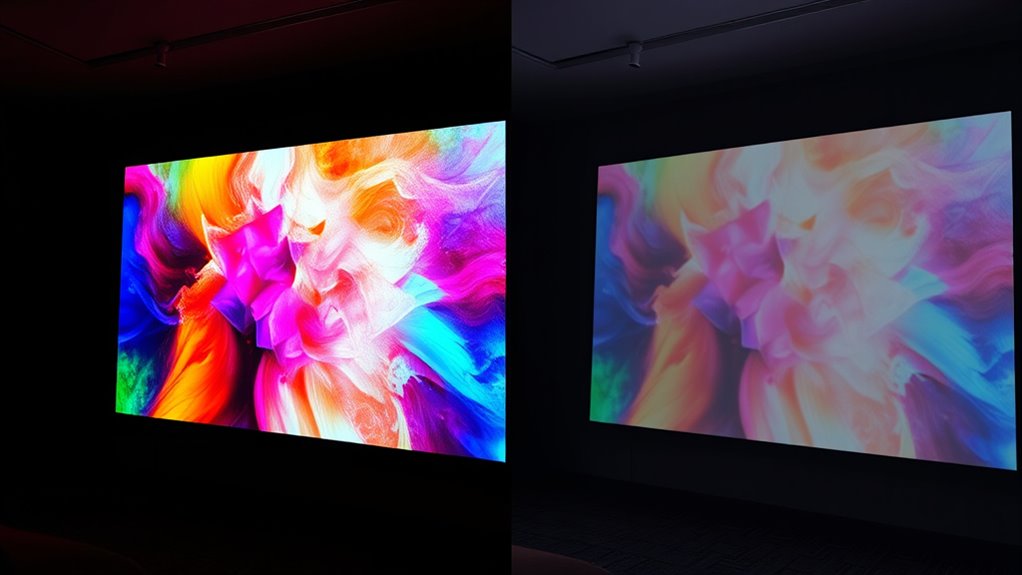
Have you ever noticed that white projection screens often deliver more accurate and vibrant colors? That’s because white screens typically provide better color accuracy compared to other types. Their neutral surface reflects light evenly, ensuring that colors appear true to life without distortion. Unlike specialized screens that might enhance contrast or reduce ambient light, white screens focus on maintaining the integrity of the original image’s colors. This makes them ideal for applications where accurate color representation is essential, such as professional presentations or home theaters. When color fidelity matters most, white screens are a reliable choice. They deliver crisp, vibrant visuals that stay true to the source, giving you a richer viewing experience with true-to-life colors.
Screen Material and Design Don’t Matter as Much as Color

Does the material or design of your screen really matter more than the colors it displays? Not entirely. While a well-designed screen can optimize projection angles and reduce glare, the core factor remains color accuracy. Modern screens, whether ALR or white, focus more on how well they showcase colors than their material. Sound integration is also essential; a screen’s design shouldn’t hinder audio quality. Ultimately, if the colors are vivid and true to life, your viewing experience improves regardless of minor material differences. The key is selecting a screen that enhances color presentation and minimizes reflection, rather than obsessing over material or intricate design details. Good color performance ensures you get the most out of your projector, regardless of the screen’s surface or structure.
Frequently Asked Questions
Can White Screens Be Effective in Bright Rooms?
White screens can be effective in bright rooms if they have proper glare reduction features. They reflect ambient light, which may cause some glare, but quality white screens designed for high ambient light conditions help maintain visual clarity. To get the best results, choose a white screen with a matte surface or anti-reflective coating, ensuring you enjoy clear images even in bright environments without sacrificing brightness or detail.
Are All ALR Screens Equally Suitable for Gaming?
Not all ALR screens are equally suitable for gaming. When choosing, consider screen installation and screen size considerations to get the best experience. Look for screens with fast refresh rates and low latency, which enhance gameplay. Proper screen size guarantees immersive viewing without sacrificing image clarity. Some ALR screens are optimized for gaming, while others focus on movies or presentations, so pick one that matches your gaming setup and space requirements.
Do Expensive Screens Always Outperform Cheaper Options?
Money doesn’t always buy brilliance, and expensive screens aren’t guaranteed to outperform cheaper options. Think of screen cost as a vessel, but performance expectations are what truly fill it. You might find a budget-friendly screen that meets your needs perfectly, offering sharp images and good contrast. Don’t assume higher price tags promise better results—evaluate features and performance to find the right fit for your gaming experience.
How Does Ambient Light Rejection Impact Picture Quality?
Ambient light rejection markedly impacts picture clarity by minimizing the interference of ambient light in your viewing area. When your screen effectively blocks out ambient light, you’ll notice brighter, more vivid images with sharper details. This means you don’t have to dim your room as much, and the picture quality remains consistent regardless of the lighting conditions. Investing in an ALR screen can enhance your overall viewing experience, especially in well-lit environments.
Do Different Screen Materials Affect Color Accuracy Significantly?
Different screen materials can markedly affect your color accuracy. Some materials are prone to color shift over time, especially with prolonged use or exposure to sunlight. Durability also varies; higher-quality materials resist scratches and fading, maintaining picture quality longer. When choosing a screen, consider both how well it preserves true colors and its durability, ensuring you get vibrant, accurate images without frequent replacements or adjustments.
Conclusion
So, there you have it—your quick guide to avoiding the pitfalls of projector screen myths. Remember, choosing between ALR and white screens isn’t just about brightness or price; it’s about understanding what truly matters. But hey, who needs facts when you can rely on buzzwords and assumptions? Next time you shop, just toss a coin and hope for the best—after all, your movie nights are bound to be as perfect as the myths you’ve been told.






